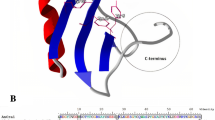Abstract
The Asian scorpion Buthus martensil Karsch is important in the Chinese traditional medicine where it is used for the treatment of some nervous system diseases. The anti-epilepsy peptide (AEP) is a 61-amino-acid polypeptide extracted from the venom of B. martensil Karsch. Research has confirmed that it has anti-epileptic effects on the rat model of epilepsy. In this experiment, a cDNA library of AEP from the venom of B. martensil Karsch was constructed using RT-PCR; the primer was designed and used for the amplification. An expression vector of AEP was constructed using Pichia pastoris. Vector expression was induced, and protein purification was then performed. Bolting of the interaction molecule of AEP was by His pull down. Experimental results indicate high AEP expression, and the obtained protein was purified and compared with the control group. Four conspicuous protein bands were observed, and mass chromatographic analysis indicated that the four proteins were synaptosomal-associated protein of 25 kDa (SNAP-25), glial fibrillary acidic protein (GFAP), Glutamic acid decarboxylase (GAD) and N-methyl-d-aspartate (NMDA). Further, the four protein bands were verified by mammalian two-hybrid experiments and co-immunoprecipitation. AEP was found to interact with SNAP2 and NMDA. This provides experimental evidence for the mechanism of AEP’s anti-epileptic action and for the manufacture of a novel type anti-epileptic drug.





Similar content being viewed by others
References
Zhou X-H, Yang D, Zhang J-H et al (1989) Purification and N-terminal partial sequence of anti-epilepsy peptide from venom of the scorpion Buthus martensii Karsch. Biochem J 257:509–517
Wang C-G, He X-L, Shao F et al (2001) Molecular characterization of an anti-epilepsy peptide from the scorpion Buthus martensi Karsch. Eur J Biochem 268:2480–2485. doi:10.1046/j.1432-1327.2001.02132.x
Wang Z, Shao Z, Li J et al (2005) Construction and identification of recombinant adeno-associated virus transducing antiepilepsy peptide gene. Chin Tradit Herb Drugs 36:1844–1846
Gong X, Zhou L, Zeng D et al Construction of native human prothymosin α by prokaryotic coexpression. Chinese Patents (1724663)
Park HS, Park D, Bae YS (2006) Molecular interaction of NADPH oxidase 1 with β Pix and Nox Organizer 1. Biochem Biophys Res Commun 339:985–990. doi:10.1016/j.bbrc.2005.11.108
Kang S-W, Shin Y-J, Shim Y-J et al (2005) Clusterin interacts with SCLIP (SCG10-like protein) and promotes neurite outgrowth of PC12 cells. Exp Cell Res 309:305–315. doi:10.1016/j.yexcr.2005.06.012
Lee S-Y (2005) Identification of a protein that interacts with the vanilloid receptor. Biochem Biophys Res Commun 331:1445–1451. doi:10.1016/j.bbrc.2005.04.066
Yang X, Li J, Qin H et al (2005) Mint represses transactivation of the type II collagen gene enhancer through interaction with αA-crystallin-binding protein 1. J Biol Chem 280:18710–18716. doi:10.1074/jbc.M500859200
Corona M, Coronas FV, Merino E et al (2003) A novel class of peptide found in scorpion venom with neurodepressant effects in peripheral and central nervous system of the rat. Biochim Biophys Acta 1649:58–67
Bosmans F, Tytgat J (2007) Voltage-gated sodium channel modulation by scorpion a-toxins. Toxicon 49:142–158
Nong Y, Huang YQ, Ju W et al (2003) Glycine binding primes NMDA receptor internalization. Nature 6929:302–307. doi:10.1038/nature01497
Harrington EP, Möddel G, Najm IM et al (2007) Altered glutamate receptor—transporter expression and spontaneous seizures in rats exposed to methylazoxymethanol in utero. Epilepsia 48:158–168. doi:10.1111/j.1528-1167.2006.00838.x
Ikonomidou C, Bosch F, Miksa M et al (1999) Blockade of NMDA receptors and apoptotic neurodegeneration in the developing brain. Science 284:336
Huang Y, Zuo P (2007) The modulation of Buthus martensic Karch Extract (BmKE) on Cerebral Cortex NMDA Receptor and GABA Receptor in Epileptic Mice. Lishizhen Med Materia Medica Res 18:71–73
Weiss JM, Huller H, Polack S et al (2007) Estradiol differentially modulates the exocytotic proteins SNAP-25 and munc-18 in pituitary gonadotrophs. J Mol Endocrinol 38:305–314. doi:10.1677/jme.1.02114
Sierra-Paredes G, Sierra-Marcuño G (2007) Extrasynaptic GABA and glutamate receptors in epilepsy. CNS Neurol Disord Drug Targets 6:288–300. doi:10.2174/187152707781387251
Kataoka M, Kuwahara R, Matsuo R et al (2006) Development and activity-dependent regulation of SNAP-25 phosphorylation in rat brain. Neurosci Lett 407:258–262. doi:10.1016/j.neulet.2006.08.055
Apland JP, Adler M, Oyler GA (2003) Inhibition of neurotransmitter release by peptides that mimic the N-terminal domain of SNAP-25. J Protein Chem 22:147–153. doi:10.1023/A:1023423013741
Costantin L, Bozzi Y, Richichi C et al (2005) Antiepileptic effects of botulinum neurotoxin E. J Neurosci 25:1943–1951. doi:10.1523/JNEUROSCI.4402-04.2005
Hinz B, Becher A, Mitter D et al (2001) Activity-dependent changes of the presynaptic synaptophysin-synaptobrevin complex in adult rat brain. Eur J Cell Biol 80:615–619. doi:10.1078/0171-9335-00196
Author information
Authors and Affiliations
Corresponding authors
Additional information
Zongren Wang and Wen Wang contributed equally to this work.
Rights and permissions
About this article
Cite this article
Wang, Z., Wang, W., Shao, Z. et al. Eukaryotic expression and purification of anti-epilepsy peptide of Buthus martensii Karsch and its protein interactions. Mol Cell Biochem 330, 97–104 (2009). https://doi.org/10.1007/s11010-009-0104-7
Received:
Accepted:
Published:
Issue Date:
DOI: https://doi.org/10.1007/s11010-009-0104-7




